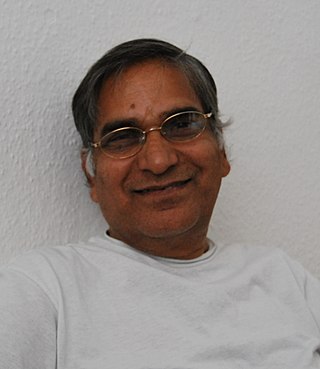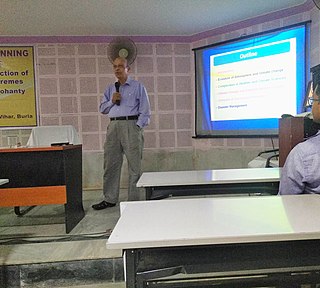Syed Mahmood Naqvi was an Indian Earth scientist specialising in geochemistry at the National Geophysical Research Institute (NGRI) in Hyderabad. In a four-decade career, from the 1960s through 2000s, he was the recipient of numerous awards, scientific as well as humanitarian, and served as Fellow of the Association of Applied Geochemists, Indian Geophysical Union, Andhra Pradesh Academy of Sciences and Indian National Science Academy (INSA) as well as vice-president of the Geological Society of India, the Geological Mining and Metallurgical Society of India and the Indian Society of Applied Geochemists (ISAG).

Harsh Kumar Gupta is an Indian earth scientist and seismologist, known for his pioneering work on estimation of reservoir-induced earthquakes. He is a former vice chancellor of the Cochin University of Science and Technology (CUSAT) and a Raja Ramanna Fellow at the National Geophysical Research Institute (NGRI), Hyderabad. A recipient of the 1983 Shanti Swarup Bhatnagar Prize for Science and Technology, the highest Indian award in the science and technology category, and the 2008 Waldo E. Smith Award, Gupta was awarded the fourth highest Indian civilian honour of the Padma Shri in 2006.
Vinod Kumar Gaur is an Indian seismologist,a former director of the National Geophysical Research Institute and an honorary emeritus scientist at CSIR Fourth Paradigm Institute, known for his prediction of the April 2015 Nepal earthquake. He is reported to have conducted extensive studies on the tectonics of the Himalayas and is an elected fellow of the National Academy of Sciences, India, The World Academy of Sciences, Indian Academy of Sciences and the Indian National Science Academy. The Council of Scientific and Industrial Research, the apex agency of the Government of India for scientific research, awarded him the Shanti Swarup Bhatnagar Prize for Science and Technology, one of the highest Indian science awards for his contributions to Earth, Atmosphere, Ocean and Planetary Sciences in 1979.
Basanta Kumar Sahu is an Indian mathematical geologist, sedimentologist and a Professor Emeritus at the Indian Institute of Technology, Bombay. He is for known for his mathematical and quantitative studies in geology and the development of statistical and mathematical models. A founder member of the founded the International Association of Mathematical Geologists, he is a member of the American Association of Petroleum Geologists and the Society of Economic Paleontologists and Mineralogists. The Council of Scientific and Industrial Research, the apex agency of the Government of India for scientific research, awarded him the Shanti Swarup Bhatnagar Prize for Science and Technology, one of the highest Indian science awards for his contributions to Earth, Atmosphere, Ocean and Planetary Sciences in 1980.
Janardan Ganpatrao Negi was an Indian theoretical geophysicist and emeritus scientist at National Geophysical Research Institute.
Kunchithapadam Gopalan is an Indian geochronologist and a former emeritus scientist at National Geophysical Research Institute. He is known for his studies on the chronologies of critical rock suites of the Indian subcontinent and is an elected fellow of the Indian Academy of Sciences, Indian National Science Academy, Indian Geophysical Union and the National Academy of Sciences, India. The Council of Scientific and Industrial Research, the apex agency of the Government of India for scientific research, awarded him the Shanti Swarup Bhatnagar Prize for Science and Technology, one of the highest Indian science awards for his contributions to earth, atmosphere, ocean and planetary sciences in 1982.
Sethunathasarma Krishnaswami, popularly known as Swami, was an Indian geochemist and an honorary scientist at the geosciences division of the Physical Research Laboratory. He was known for his studies on low temperature geochemistry and was an elected fellow of the Indian Academy of Sciences, Indian National Science Academy, The World Academy of Sciences, National Academy of Sciences, India, American Geophysical Union, Geochemical Society and European Association of Geochemistry (2003). The Council of Scientific and Industrial Research, the apex agency of the Government of India for scientific research, awarded him the Shanti Swarup Bhatnagar Prize for Science and Technology, one of the highest Indian science awards for his contributions to Earth, atmosphere, ocean and planetary Sciences in 1984.
Kumarendra Mallick is an Indian geophysicist, poet and a former emeritus scientist at the National Geophysical Research Institute, Hyderabad, A former assistant professor of the Indian Institute of Technology, Mumbai, he served as a director-grade scientist at NGRI. He is the author of three books on geophysics, a poem anthology, Letter to an Imaginary Pen-Friend and several articles.
Pramod Sadasheo Moharir was an Indian geophysicist and a former senior scientist at the National Geophysical Research Institute. He was known for his studies on geophysical signal processing.

Sri Niwas (1946–2012) was an Indian geophysicist and a professor at the Department of Earth Sciences of the Indian Institute of Technology, Roorkee. He was known for his researches on the Inversion of Geophysical Data. He was an elected fellow of all the three major Indian science academies viz. Indian National Science Academy, Indian Academy of Sciences, National Academy of Sciences, India as well as Indian Geophysical Union and was an elected member of the Association of Exploration Geophysicists. The Council of Scientific and Industrial Research, the apex agency of the Government of India for scientific research, awarded him the Shanti Swarup Bhatnagar Prize for Science and Technology, one of the highest Indian science awards for his contributions to Earth, Atmosphere, Ocean and Planetary Sciences in 1991.

Uma Charan Mohanty is an Indian meteorologist and an emeritus professor at the School of Earth, Ocean and Climate Sciences of the Indian Institute of Technology, Bhubaneswar. He is the president of Odisha Bigyan Academy and is known for his researches on the Indian summer monsoon. Besides being an elected fellow of the Indian Geophysical Union, he is also an elected fellow of all the three major Indian science academies viz. Indian National Science Academy, Indian Academy of Sciences, and the National Academy of Sciences, India. The Council of Scientific and Industrial Research, the apex agency of the Government of India for scientific research, awarded him the Shanti Swarup Bhatnagar Prize for Science and Technology, one of the highest Indian science awards, for his contributions to Earth, Atmosphere, Ocean and Planetary Sciences in 1993.
Shyam Sundar Rai is an Indian seismologist and a former chair professor at the department of Earth and Climate Science of the Indian Institute of Science Education and Research, Pune. He is known for his researches on the seismic structure of Indian continental lithosphere and is an elected fellow of all the three major Indian science academies viz. Indian National Science Academy, Indian Academy of Sciences, and the National Academy of Sciences, India as well as of the Indian Geophysical Union. The Council of Scientific and Industrial Research, the apex agency of the Government of India for scientific research, awarded him the Shanti Swarup Bhatnagar Prize for Science and Technology, one of the highest Indian science awards for his contributions to Earth, Atmosphere, Ocean and Planetary Sciences in 1996.

Rengaswamy Ramesh (1956–2018) was an Indian climatologist, oceanographer, a former Prof. Satish Dhawan Professor at the Physical Research Laboratory and a senior professor at the National Institute of Science Education and Research, Bhubaneswar. He was known for paleo-climatic and paleo-oceanographic studies and was an elected fellow of all the three major Indian science academies viz. Indian National Science Academy, Indian Academy of Sciences, and the National Academy of Sciences, India as well as of The World Academy of Sciences. The Council of Scientific and Industrial Research, the apex agency of the Government of India for scientific research, awarded him the Shanti Swarup Bhatnagar Prize for Science and Technology, one of the highest Indian science awards for his contributions to Earth, Atmosphere, Ocean and Planetary Sciences in 1998.
Kolluru Sree Krishna is an Indian marine geophysicist and former chief scientist at the National Institute of Oceanography, India. He is known for his studies on the evolution of the Indian Ocean and is an elected fellow of all the three major Indian science academies: Indian National Science Academy, Indian Academy of Sciences, and the National Academy of Sciences, India. The Council of Scientific and Industrial Research, the apex agency of the Government of India for scientific research, awarded him the Shanti Swarup Bhatnagar Prize for Science and Technology, one of the highest Indian science awards for his contributions to Earth, Atmosphere, Ocean and Planetary Sciences in 2001.
Sankar Kumar Nath is an Indian geophysicist, seismologist and a senior professor at the Indian Institute of Technology Kharagpur. He is known for his geotomographical studies and is an elected fellow of the Indian National Academy of Engineering, Indian Geophysical Union and the National Academy of Sciences, India, The Council of Scientific and Industrial Research, the apex agency of the Government of India for scientific research, awarded him the Shanti Swarup Bhatnagar Prize for Science and Technology, one of the highest Indian science awards for his contributions to Earth, Atmosphere, Ocean and Planetary Sciences in 2002.
Ganapati Shankar Bhat is an Indian geophysicist and the chairman of the Centre for Atmospheric and Oceanic Sciences of the Indian Institute of Science. He is known for his studies on atmospheric convective processes and air-sea interactions and is an elected fellow of the Indian Academy of Sciences. The Council of Scientific and Industrial Research, the apex agency of the Government of India for scientific research, awarded him the Shanti Swarup Bhatnagar Prize for Science and Technology, one of the highest Indian science awards for his contributions to Earth, Atmosphere, Ocean and Planetary Sciences in 2002.
Gufran-Ullah Beig is an Indian meteorologist and a scientist at the Indian Institute of Tropical Meteorology, Pune. He is the programme director of System of Air Quality Forecasting and Research (SAFAR), a network of air quality and weather monitoring stations, which assists in the forecast of air quality and in maintaining an emission inventory. An elected fellow of the Indian Academy of Sciences, he received the Norbert Gerbier-Mumm International Award of the World Meteorological Organization in 2005, the first Indian to receive the honor. The Council of Scientific and Industrial Research, the apex agency of the Government of India for scientific research, awarded him the Shanti Swarup Bhatnagar Prize for Science and Technology, one of the highest Indian science awards for his contributions to Earth, Atmosphere, Ocean and Planetary Sciences in 2006.
Jyotiranjan Srichandan Ray is an Indian geochemist, geochronologist and a professor at the Physical Research Laboratory. He is known for his studies on the geochronology of the Indian subcontinent and his studies have been documented in several peer-reviewed articles; ResearchGate and Google Scholar, online repositories of scientific articles, have listed 53 and 59 of them respectively. He has authored a book, Vindhyan Geology: Status and Perspectives, published in 2006 by the Indian Academy of Sciences and has also contributed chapters to books published by others. He served as director of National Centre for Earth Science Studies,(NCESS) situated in Thiruvananthapuram, Kerala(India) from September 2020 to September 2023.
S. Suresh Babu is an Indian atmospheric scientist and the head of the Aerosols, Trace gases and Radiative Forcing (ATRF) branch at the Space Physics Laboratory of Vikram Sarabhai Space Centre. Known for his studies on the Atmospheric aerosols, Babu is a recipient of the Young Scientist or Associate Award of all the three major Indian science academies namely, National Academy of Sciences, India, Indian Academy of Sciences and Indian National Science Academy. The Council of Scientific and Industrial Research, the apex agency of the Government of India for scientific research, awarded him the Shanti Swarup Bhatnagar Prize for Science and Technology, one of the highest Indian science awards, for his contributions to Earth, Atmosphere, Ocean and Planetary Sciences in 2017.
Subimal Ghosh is Institute Chair Professor in the Department of Civil Engineering and Convener of the Interdisciplinary Program in Climate Studies at Indian Institute of Technology Bombay with research interests in hydrology and hydro-climatology. He obtained PhD degree in 2007 from Indian Institute of Science, Bangalore on a thesis titled "Hydrologic Impacts of Climate Change: Uncertainty Modelling", and ME degree in 2004 from the same institute.




